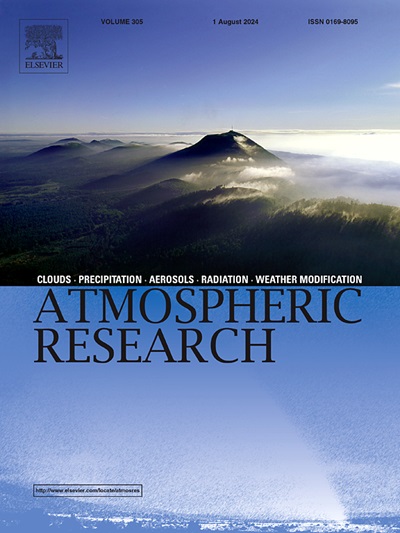Optical and particulate properties of dust aerosols in El Paso, Texas
IF 4.5
2区 地球科学
Q1 METEOROLOGY & ATMOSPHERIC SCIENCES
引用次数: 0
Abstract
We characterized optical properties (absorption, scattering, and backscattering coefficients, Ångström exponents, single scattering albedo) of aerosols during dust events at an urban site in El Paso, Texas using in-situ, real-time measurements. Simultaneous measurements of particulate matter (PM10, PM2.5) and wind data from an adjacent Texas Commission on Environmental Quality Continuous Ambient Monitoring Station are used in this study. Data from both sites was obtained at 5-min resolution. Twenty-seven dust events (15 synoptic, 12 mesoscale) occurred during 24 days from April–June 2021. HYSPLIT and STILT back-trajectories indicated many dust events (∼46 %) originated from the west-southwest (favoring transport across dust source areas in the Chihuahuan Desert). Mean absorption Ångström exponent values of El Paso dust (1.19 and 1.15 for synoptic and mesoscale events) were lower than published values for “pure” dust at other locations (generally accepted as greater than 2). Single scattering albedo values averaged 0.94 during synoptic and mesoscale dust events, confirming the scattering nature of mineral dust in the region. PM10 and PM2.5 concentrations averaged 191 and 41 μg/m3 during dust event periods versus 28 and 8.7 μg/m3 during non-event (background) periods. Absorption / scattering Ångström exponent ratios of dust event aerosols were representative of large particles-black carbon mixture rather than a “pure” dust, suggesting mixing with urban aerosols, while many observations during non-event periods fall into the large particles-black carbon mixture and large particles-low absorption categories, suggesting that dust is a constant key component of the aerosols in El Paso. The 5-min time resolution revealed the evolution of complex aerosol events (e.g., brown carbon followed by dust, multiple dust events within one day, fireworks, advection of low-absorption gypsum dust from White Sands. New Mexico), emphasizing the importance of detecting and quantifying high intensity, short-duration events “lost” in 24-h or hourly air quality data.
德克萨斯州埃尔帕索市尘埃气溶胶的光学和颗粒特性
我们在德克萨斯州埃尔帕索的一个城市站点使用原位实时测量方法描述了沙尘事件期间气溶胶的光学特性(吸收、散射和后向散射系数、Ångström 指数、单散射反照率)。本研究使用了相邻的德克萨斯州环境质量委员会连续环境监测站的颗粒物(PM10、PM2.5)和风数据的同步测量数据。两个站点的数据均以 5 分钟的分辨率获取。2021 年 4 月至 6 月的 24 天内发生了 27 起沙尘事件(15 起为同步事件,12 起为中尺度事件)。HYSPLIT 和 STILT 后向轨迹显示,许多沙尘事件(46%)来自西南偏西方向(有利于穿越奇瓦瓦沙漠的沙尘源区)。埃尔帕索沙尘的平均吸收 Ångström 指数值(同步和中尺度事件分别为 1.19 和 1.15)低于其他地点已公布的 "纯 "沙尘值(一般认为大于 2)。在同步和中尺度沙尘事件中,单一散射反照率值平均为 0.94,证实了该地区矿物沙尘的散射性质。在沙尘事件期间,PM10 和 PM2.5 的平均浓度分别为 191 微克/立方米和 41 微克/立方米,而在非事件(背景)期间则分别为 28 微克/立方米和 8.7 微克/立方米。沙尘事件气溶胶的吸收/散射 Ångström 指数比代表大颗粒-黑碳混合物,而不是 "纯 "沙尘,表明与城市气溶胶混合,而非事件期间的许多观测结果属于大颗粒-黑碳混合物和大颗粒-低吸收类别,表明沙尘是埃尔帕索气溶胶的一个固定的关键组成部分。5 分钟的时间分辨率揭示了复杂气溶胶事件的演变过程(例如,先有棕碳后有灰尘、一天内有多个灰尘事件、焰火、来自白沙的低吸收石膏灰尘的平流),强调了气溶胶在新墨西哥州的重要性。新墨西哥州),强调了检测和量化 24 小时或每小时空气质量数据中 "丢失 "的高强度、短持续时间事件的重要性。
本文章由计算机程序翻译,如有差异,请以英文原文为准。
求助全文
约1分钟内获得全文
求助全文
来源期刊

Atmospheric Research
地学-气象与大气科学
CiteScore
9.40
自引率
10.90%
发文量
460
审稿时长
47 days
期刊介绍:
The journal publishes scientific papers (research papers, review articles, letters and notes) dealing with the part of the atmosphere where meteorological events occur. Attention is given to all processes extending from the earth surface to the tropopause, but special emphasis continues to be devoted to the physics of clouds, mesoscale meteorology and air pollution, i.e. atmospheric aerosols; microphysical processes; cloud dynamics and thermodynamics; numerical simulation, climatology, climate change and weather modification.
 求助内容:
求助内容: 应助结果提醒方式:
应助结果提醒方式:


